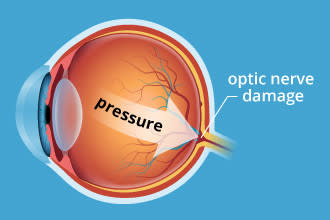Glaucoma types: Symptoms, treatment and prevention

Glaucoma is often called the "silent thief of sight," because most of its types typically cause no pain and produce no symptoms until noticeable vision loss occurs.
For this reason, glaucoma often progresses undetected until the optic nerve already has been irreversibly damaged.
What is glaucoma?
Glaucoma is a group of related eye disorders that cause damage to the optic nerve that carries information from the eye to the brain.
In most cases, glaucoma is associated with higher-than-normal pressure inside the eye — a condition called ocular hypertension. But it can also occur when intraocular pressure (IOP) is normal. If untreated or uncontrolled, glaucoma first causes peripheral vision loss and eventually can lead to blindness.

In most types of glaucoma, elevated intraocular pressure (IOP) is associated with damage to the optic nerve in the back of the eye.
Glaucoma is the second-leading cause of blindness worldwide (behind cataracts).
Types of glaucoma
The two major categories of glaucoma are open-angle glaucoma and closed angle glaucoma. The "angle" in both cases refers to the drainage angle inside the eye that controls the outflow of the watery fluid (aqueous) which is continually being produced inside the eye.
If the aqueous can access the drainage angle, the glaucoma is known as open angle glaucoma. If the drainage angle is blocked and the aqueous cannot reach it, the glaucoma is known as closed angle glaucoma.
Glaucoma symptoms
Most types of glaucoma typically cause no pain and produce no symptoms until noticeable vision loss occurs, but with acute angle-closure glaucoma, one experiences sudden symptoms like blurry vision, halos around lights, intense eye pain, nausea and vomiting.
If you have these symptoms, see an optician so steps can be taken to prevent permanent vision loss.
Diagnosis, screening and tests for glaucoma
During routine eye exams, a tonometer is used to measure your intraocular pressure, or IOP. Your eye typically is numbed with eye drops, and a small probe gently rests against your eye's surface. Other tonometers send a puff of air onto your eye's surface.
An abnormally high IOP reading indicates a problem with the amount of fluid (aqueous humour) in the eye. Either the eye is producing too much fluid, or it's not draining properly.
Normally, IOP should be below 21 mmHg (millimeters of mercury) — a unit of measurement based on how much force is exerted within a certain defined area.
If your IOP is higher than 30 mmHg, your risk of vision loss from glaucoma is 40 times greater than someone with intraocular pressure of 15 mmHg or lower. This is why glaucoma treatments such as eye drops are designed to keep IOP low.
Other methods of monitoring glaucoma involve the use of sophisticated imaging technology to create baseline images and measurements of the eye's optic nerve and internal structures.
Then, at specified intervals, additional images and measurements are taken to make sure no changes have occurred that might indicate progressive glaucoma damage.
Glaucoma treatments
Treatment for glaucoma can involve surgery, laser treatment or medication, depending on the severity. Eye drops with medication aimed at lowering IOP are usually tried first to control glaucoma.
Because glaucoma is often painless, people may become careless about strict use of eye drops that can control eye pressure and help to prevent permanent eye damage.
In fact, not complying with a prescribed glaucoma medication program is one of the major reasons for blindness caused by glaucoma.
If you find that the eye drops you are using for glaucoma are uncomfortable or inconvenient, never discontinue them without first consulting your optician about a possible alternative therapy.
Exercise may cut glaucoma risk
Can you reduce the glaucoma risk? According to a recent European study, exercise lessens the chance that some people will develop glaucoma because it helps improve blood flow in your body and your eyes.
In addition to regular exercise and an active lifestyle, you also can reduce your risk for glaucoma by not smoking, maintaining a healthy weight, and eating a varied and healthy diet.
FIND AN OPTICIAN: An optician can assess your vision, find an optician near you.
Page published on Wednesday, 26 June 2019






